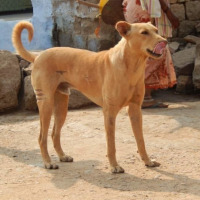 |
Pandikona |
|
He is not recognized by the F.C.I. |
Origin |
India | |
Translation |
Francis Vandersteen |
| The Indian Pandikona is one of the forgotten breeds of Andra Pradesh. The Pandikona is named after its location. Pandikona is located near the Kurnool district in Andhra Pradesh. This highly territorial breed is used to guard villages, properties and livestock, and to hunt any available game. Their territorial nature and strong temperament often lead to fights with neighboring dogs encroaching on their territory. Given that Pandikona is a small village with overlapping property boundaries, and that most houses have 2-3 dogs, it's only natural that dogs will occasionally stand and fight on the border. Most quarrels end with one dog retiring without serious injury. Villagers don't normally intervene in territorial dog fights. These intelligent, independent dogs are never chained, but roam freely around the village, not following their owners' instructions. They normally stay close to their property and take their guarding duties seriously. When bored or satisfied with their owner's security, the dogs go to their owner's farm and continue to watch over him. Perfectly suited to guarding or hunting duties, the Pandikona is a fierce protector that tolerates stray children and youngsters, but is deadly serious with adults. The Pandikona will normally warn the intruder to stay away, but the warning is short-lived and the impending attack is carried out quickly and with great intensity. Adult Pandikona dogs are focused and confident in their defensive abilities, and exercise good judgment when confronted with a young or juvenile animal. Their hunting function is carried out in the traditional way with weapons that have been used for generations. Normally done with a spear or "ballem", which is a sharp metal end attached to a stick. Hunting in this way exposes the hunter and dogs to the danger of wild boar and other animals. Dogs hunt in packs with a leader established by pack order, and all territorial disagreements are forgotten during the hunt. Generally, the leader has the best nose and bite and sets off to hunt boar, followed by the pack at a discreet distance. It is said that the pack has a complex communication system that enables the leader to warn the pack of dangers such as snakes, scorpions and whether he has found the prey. If the prey is very large, the leader will take the first bite and slaughter it. If the prey is not very difficult, the leader will allow the junior leader to bite the first bite and bring down the prey with the other one who participates in the kill. Puppies join the hunt between 6 and 8 months of age. One of the enthusiastic volunteers (a doctor) actually spoke to a few villagers and learned that in 2010, following a dispute in the village, over 25 hunting dogs had been killed due to night-time poisoning. This was done by an elderly and selfish person in the village itself and he concluded that this was perhaps the reason why the size and grandeur of these dogs had diminished a little because the villagers had lost interest in hunting because of this incident. |






 English (United Kingdom)
English (United Kingdom)